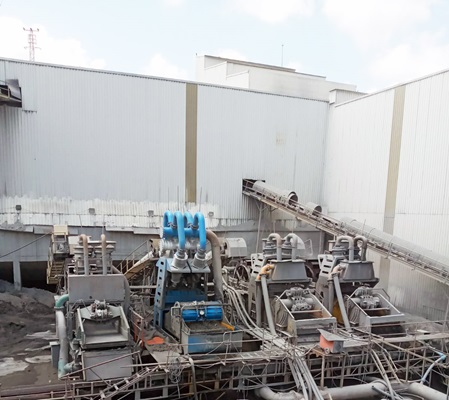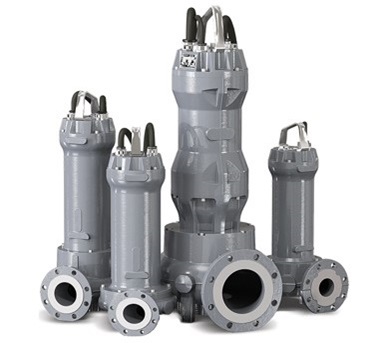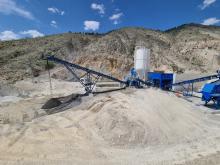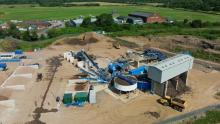CCP Building Products owns the Aberdo quarry at Pentre Halkyn and produces quality limestone aggregates that supply the markets of North Wales, Cheshire, Lancashire, Liverpool and Manchester.
In late May this year, the quarry started operating a Terex WS FP215 filter press, which features 1.5m x 2m filter plates and an automated control system.
CCP Building Products says the TWS-supplied wash plant doubles the output from its quarry operation, working alongside the quarry's current crushing process.
The washing plant allows the quarry to produce high-quality premium limestone aggregates in 10mm, 20mm, 40mm and 4/20mm sizes. The wash process also has a quality manufactured 0/4mm limestone sand for concrete production. Much of that material production is currently generated from the years of quarry overburden stockpiled onsite as a 'waste' material, which the plant was designed to process.
Terex Washing Systems describes the installation at Aberdo as a 'Feeder to Filter press' because all the wash-plant machinery and crushing and screening equipment at the site is designed, manufactured and supplied by Terex Washing Systems and its other sister brands. These include a Powerscreen Metrotrack jaw crusher at the front end, a Powerscreen Warrior 2100 scalping screen, a Powerscreen Premiertrack 1150 cone crusher, a TWS AggreSand 206 sand-washing plant, a TWS AggreSand 150 scrubbing plant, a TWS FDU (flocculant dosing unit) 5000, TWS Rake thickener, buffer tanks and the FP215 Filterpress.
Fergal McPhillips, global business development manager for TWS, says that having all the plants from Terex-owned brands is a major benefit for the operator from a servicing and parts perspective as it is a 'one-stop-shop'.
"There is a lot of interest in this deployment around the filter press itself," he adds. "Health and safety is very high on the priority list for our filter presses. It has stainless steel sliding isolation doors, and the automated maintenance and control system means it is user-friendly."
More than 95% of the water in the water-treatment process at the quarry is recycled by the Terex WS system. The filter press and washing plant produce 20-tonnes of dry filter-cake waste product, which is put back into the quarry.

"The filter press is in place to recycle the maximum volume of water, minimise the water usage, and produce a dry filter cake that is easy to transport," McPhillips says. "The recycled water is fed back into the washing process."
CCP Building Products says that, from render and floor screeds to concrete materials and paving courses, the washed aggregates the quarry produces have various uses.
"Their versatility, high quality, strength and workability make them ideal for all kinds of projects and uses, including the production of concrete, asphalt, drainage and landscaping projects, to name just a few," it adds.
Washed aggregates undergo a specialised process to remove impurities, such as clay, silt, dust and other unwanted particles, which can hurt the strength and workability of concrete, one of their key uses. The washing process also eliminates sulphate and chloride to meet the specifications for the British standard of sand used in concrete. Washed aggregates provide numerous advantages over non-washed by ensuring cleanliness and adhering to quality standards.
Terex Washing Systems has a history of deploying similar filter presses across Europe and the USA, designed and manufactured at its HQ in Dungannon, Northern Ireland.
Turkish concrete producer Boğçziçi Beton has commissioned a new CDE wash plant to increase output levels.
Established in 1997, Boğaziçi Beton has 28 separate concrete batching plants in Turkey, pouring six million m3/year. The firm has run some 35 million m3 of concrete used in major construction projects in Istanbul, including the new central bank, metro construction projects, highways and viaducts and high-rise buildings in the financial district.
The firm took over a 50-acre quarry in the Kemerburgaz-Cendere region in 2015 to begin processing crushed sand and aggregates for its concrete production.
The following year, Boğazççi Beton increased crushing-plant capacity at its Cendere quarry to 2,000tph, enabling the firm to process up to six million tonnes of crushed material annually.
In Kemerburgaz, where Boğçziçi Beton's site is located, all quarries have natural sandstone with a major water-absorption problem in crushed sand.
With approximately 15-17% of 0–63-micron content after crushing, Boğazççi Beton was producing methylene blue test results above the acceptable limits, resulting in higher production costs due to the need to add additional cement to the concrete mix.

Seeking to address this, Boğçziçi Beton engaged with wet-processing experts CDE to design and commission a plant to remove excess fines content in its sand and decrease water absorption to achieve a lower methylene blue result in line with industry standards.
The issue central to Boğazççi Beton's high methylene blue values is the integration of bucket wheels in the existing plant, which increase water absorption.
CDE commissioned a 220tph EvoWash 251 to help improve the quality of the product whilst also increasing outputs.
A compact, modular sand-washing system, CDE's EvoWash screens and separates the smaller sand and gravel fractions through an integrated high-frequency dewatering screen, the hydrocyclone technology provides unrivalled control of silt cut points and eliminates the loss of quality fines.
The feed material is delivered to the plant dry before being adequately fluidised. From here, it is pumped to dual 500mm cyclones via an integrated slurry pump to remove minus 63-micron fines from the product.
By removing the fines, the product has a maximum of 3% 0–63-micron content, which dramatically changes the methylene blue quality measure of the material, aligning it with industry standard.
The EvoWash 251 was seamlessly integrated to process the fines material efficiently. The resulting output contains a maximum of 2.5%–0–63-micron content, down significantly compared to the dry crushing process output.
Japan-based water pump manufacturer Tsurumi Pump exhibited a major display of its latest pumps, technologies and services at WEFTEC from October 1–4 at McCormick Place in Chicago.
Tsurumi displayed its newest line of wastewater submersible pumps, the AVANT MY Series, to the public for the first time. These pumps are built to the same standards under the Tsurumi AVANT™ line of explosion-proof, FM-approved submersible pumps. These durable pumps feature multiple impeller options and have an accessible price point.
"The MY Series is more of an on-the-shelf option and is designed for industrial and smaller municipal applications," said Chris Bristol, municipal product sales manager at Tsurumi. "It's an economic option for smaller manufacturing and municipal wastewater facilities. Our pumps are known to be very reliable and last for many years, but it's good to know that on-the-shelf availability means quicker turnaround times for customers."
Along with the MY Series, Tsurumi is introducing new FM-approved MMR Series submersible mixers, which feature built-in IE3 premium-efficiency motors. Submersible mixers are the most practical and efficient solution for mixing, agitating, homogenising and equalising wastewater at treatment facilities. They are used in aerobic as well as anaerobic and anoxic stages of wastewater treatment processes to prevent sedimentation and maintain constant concentration levels in the tanks.
US-based McLanahan has analysed which type of dewatering equipment is best for managing tailings: a decanter centrifuge, a belt press, or a filter press.
All aggregate and mining operations with a wet-processing plant will produce a waste stream. This waste stream consists of tailings – the process water and fine solids, clay and other harmful material removed during the washing process. Traditionally, these tailings are sent to a settling pond or lagoon to separate the solids from the liquid in the waste stream.
However, McLanahan says settling ponds can be time-consuming and expensive to maintain, take up valuable land space and cover up mineable reserves. They are not the best method for tailings management, especially when mechanical dewatering options are available.
It adds that mechanical dewatering equipment improves tailings management by separating the solids from the liquid to produce a solids product that is suitable for mechanical handling.
Regarding tailings management, the best equipment for one site may differ from the best equipment for another. Decanter centrifuges, belt presses, and filter presses are all suitable for pond reduction/elimination, so the best depends on the site's tailings management goals.

The main thing to consider is the type of material being dewatered. Decanter centrifuges work best with material with a larger particle-size distribution and more easily dewatered. They are also ideal for materials with low clay content and less sensitive to changing feeds.
Belt presses can dewater various slurries in various applications but don't perform well with varying feed conditions.
Filter presses are ideal for dewatering tailings from mineral and aggregate wash plants, mineral concentrates and most underflow slurries from a thickener or clarifier.
However, the feed per cent of solids and particle-size distribution affects the overall dewatering efficiency of a filter press.
In terms of operational costs, decanter centrifuges and filter presses are fully automated, whereas belt presses require an operator.
Filter presses do not require the addition of chemicals to aid in dewatering, while belt presses do. Decanter centrifuges may benefit from chemicals, but that depends on dewatered material.
In terms of capital cost, belt presses are generally less of an upfront investment when compared with centrifuges and filter presses. Filter presses require ancillary equipment, such as a surge (or buffer) tank.
Maintenance costs are higher with belt presses because maintenance intervals are more frequent than centrifuges and filter presses. Belt presses require frequent belt washing, and the rollers and bearings are known for requiring frequent replacement, which means more downtime to perform maintenance.
In terms of footprint, belt presses and centrifuges take up less space than filter presses.
McLanahan states: "When determining which solution is right for handling your tailings, make sure you consider the type of material the equipment will be processing as well as the initial investment and long-term operational and maintenance costs."








